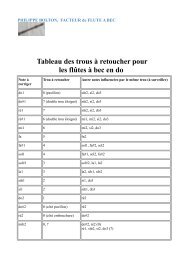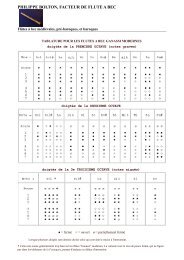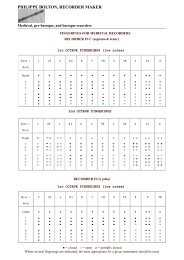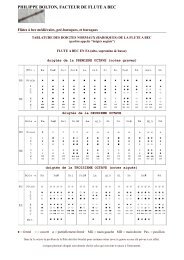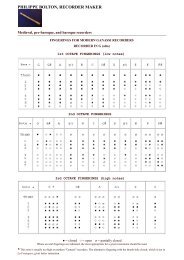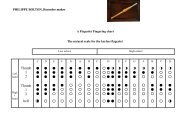Download this document in pdf format - Philippe Bolton, Facteur de ...
Download this document in pdf format - Philippe Bolton, Facteur de ...
Download this document in pdf format - Philippe Bolton, Facteur de ...
Create successful ePaper yourself
Turn your PDF publications into a flip-book with our unique Google optimized e-Paper software.
PHILIPPE BOLTON, RECORDER MAKER<br />
MAINTENANCE TIPS FOR WOODEN RECORDERS<br />
Here are some suggestions for keep<strong>in</strong>g woo<strong>de</strong>n recor<strong>de</strong>rs <strong>in</strong> good condition.<br />
1° PLAYING IN<br />
Wood needs to become accustomed to warmth & dampness caused by play<strong>in</strong>g. You must<br />
therefore play <strong>in</strong> your <strong>in</strong>strument progressively, not exceed<strong>in</strong>g the follow<strong>in</strong>g<br />
time limits :<br />
dur<strong>in</strong>g the<br />
you can play for<br />
1st week<br />
2nd week<br />
3rd week<br />
4th week<br />
10 m<strong>in</strong>utes per day<br />
15 m<strong>in</strong>utes per day<br />
15 m<strong>in</strong>utes per day<br />
30 m<strong>in</strong>utes per day<br />
After <strong>this</strong> period you can <strong>in</strong>crease the time by reasonable steps.<br />
From the beg<strong>in</strong>n<strong>in</strong>g you can play all the notes, pay<strong>in</strong>g attention to tone quality<br />
and <strong>in</strong>tonation.<br />
2° CARE OF THE RECORDER<br />
Do not expose the recor<strong>de</strong>r to excessive heat or cold, or to sud<strong>de</strong>n temperature<br />
changes. Do not therefore leave it near a radiator, <strong>in</strong> direct sunlight, <strong>in</strong> a<br />
parked car... etc. If it is cold, warm it <strong>in</strong> your hands before play<strong>in</strong>g to limit<br />
con<strong>de</strong>nsation.<br />
AFTER PLAYING...<br />
Carefully wipe out the bore with a cloth or piece of chamois leather. Then let<br />
the <strong>in</strong>strument dry out completely (especially the w<strong>in</strong>dway which cannot be wiped)<br />
before clos<strong>in</strong>g its case. It is a good i<strong>de</strong>a to use a stand for <strong>this</strong>, so that the<br />
pieces are held vertically.<br />
If the different parts become impossible to separate after a long play<strong>in</strong>g<br />
session because the jo<strong>in</strong>ts have become damp do not attempt to force them apart<br />
s<strong>in</strong>ce <strong>this</strong> could cause damage. Just wipe the <strong>in</strong>si<strong>de</strong> as shown above and let them<br />
dry out completely. This can take several hours, or even a day or two. The<br />
<strong>in</strong>strument will be easy to take apart once it is dry. To avoid <strong>this</strong> happen<strong>in</strong>g<br />
aga<strong>in</strong> take off a little thread or grease the jo<strong>in</strong>t.
IF THE WINDWAY BECOMES BLOCKED BY CONDENSATION...<br />
S<strong>in</strong>ce the <strong>in</strong>strument has been oiled dur<strong>in</strong>g mak<strong>in</strong>g, con<strong>de</strong>nsation may form <strong>in</strong> the<br />
w<strong>in</strong>dway after a few weeks. This can be easily removed with <strong>de</strong>tergent (water and<br />
wash<strong>in</strong>g-up liquid <strong>in</strong> equal parts + a little alcohol). Either take the block out<br />
and apply the liquid onto the w<strong>in</strong>dway and block surfaces us<strong>in</strong>g a Q Tip (see the<br />
<strong>document</strong> on advanced operations on the w<strong>in</strong>dway), or, without remov<strong>in</strong>g the block,<br />
use a dropper to let it flow <strong>in</strong>to the w<strong>in</strong>dow end while block<strong>in</strong>g the beak end<br />
with one f<strong>in</strong>ger. Wait for a few moments, then blow it out backwards through the<br />
beak while block<strong>in</strong>g the socket.<br />
OILING...<br />
Oil the recor<strong>de</strong>r every 3 months with l<strong>in</strong>seed oil or every month with almond oil.<br />
Use a mop, a piece of cloth fixed to a rod with a slit <strong>in</strong> the end, or even a<br />
large feather to put oil <strong>in</strong>si<strong>de</strong> the bore. You can also oil the labium spar<strong>in</strong>gly<br />
with a Q tip or small pa<strong>in</strong>tbrush but NEVER the block and w<strong>in</strong>dway. Do not<br />
overoil. Let the oil soak <strong>in</strong>to the wood for a few hours, then wipe away ALL the<br />
excess that has not been absorbed.
Let the oil soak <strong>in</strong>to the wood for a<br />
few hours, preferably keep<strong>in</strong>g the<br />
<strong>in</strong>strument <strong>in</strong> a vertical position on a<br />
stand, then wipe away ALL the excess<br />
that has not been absorbed,<br />
particularly <strong>in</strong> the bore and the holes.<br />
THREAD JOINTS...<br />
You can repair or adjust thread jo<strong>in</strong>ts yourself. If they become too loose it is<br />
often sufficient to add a little thread. If they are too tight you can take some<br />
off. For <strong>this</strong> you can use buttonhole silk which you wax with beeswax. Simply<br />
pull the thread across the wax. It should then stick to the jo<strong>in</strong>t. Be careful<br />
not to put on too much thread or there could be a risk of splitt<strong>in</strong>g the<br />
<strong>in</strong>strument. Check <strong>this</strong> by carefully try<strong>in</strong>g to assemble the recor<strong>de</strong>r as you go<br />
along. After much use it can become necessary to change the jo<strong>in</strong>t completely.<br />
Cut away the old thread without touch<strong>in</strong>g the wood, and w<strong>in</strong>d on some new waxed<br />
thread (cf draw<strong>in</strong>g below). Beg<strong>in</strong> by lay<strong>in</strong>g a loop lengthwise along the tenon,<br />
cont<strong>in</strong>ue wrapp<strong>in</strong>g the thread around it, keep<strong>in</strong>g the layer as regular as<br />
possible. As before, be careful not to put on too much. To secure the jo<strong>in</strong>t just<br />
pass the end through the loop and pull it back un<strong>de</strong>r the jo<strong>in</strong>t.<br />
Thread jo<strong>in</strong>ts that have been correctly fixed as shown above can be greased with<br />
vasel<strong>in</strong>e or with a mixture of equal parts of vasel<strong>in</strong>e and beeswax melted<br />
together <strong>in</strong> a jar heated <strong>in</strong> boil<strong>in</strong>g water.<br />
Unfixed thread will unw<strong>in</strong>d if greased.<br />
<strong>Philippe</strong> BOLTON,<br />
22 Le Grand Portail, F-84570 VILLES SUR AUZON, France<br />
TEL 04 90 61 86 11 FAX 04 90 61 97 82<br />
philippe.bolton@flute-a-bec.com<br />
http://www.flute-a-bec.com



